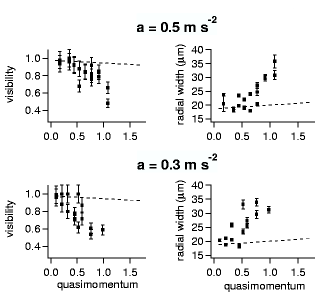 | ||||
 |
 |
| ||
 | ||||
|
Our lab and experimentsInstabilities of a Bose-Einstein condensate in a periodic potential
Abstract:  In the nonlinear problem, the solutions of the Gross-Pitaevskii equation are predicted to be unstable in the
vicinity of the Brillouin zone edge [2, 3, 4, 5]. When the condensate is close to the zone edge, the unstable
solutions grow exponentially in time, leading to a loss of phase coherence of the condensate along the direction
of the optical lattice. In our experiment, the time the condensate spends in the critical region where unstable
solutions exists is varied through the lattice acceleration. When the acceleration is small, the condensate moves
across the Brillouin zone more slowly and hence the growth of the unstable modes [2] becomes more important.
Figures 1 (c) and (d) show typical integrated profiles of the interference pattern for a lattice acceleration
a = 0.3 m/s2. Here, the condensate has reached the same point close to the Brillouin zone edge as in Figs. 1 (a)
and (b), but because of the longer time it has spent in the unstable region, the interference pattern is almost
completely washed out. It is also evident that the radial expansion of the condensate is considerably enhanced
when the Brillouin zone is scanned with a small acceleration.
In the nonlinear problem, the solutions of the Gross-Pitaevskii equation are predicted to be unstable in the
vicinity of the Brillouin zone edge [2, 3, 4, 5]. When the condensate is close to the zone edge, the unstable
solutions grow exponentially in time, leading to a loss of phase coherence of the condensate along the direction
of the optical lattice. In our experiment, the time the condensate spends in the critical region where unstable
solutions exists is varied through the lattice acceleration. When the acceleration is small, the condensate moves
across the Brillouin zone more slowly and hence the growth of the unstable modes [2] becomes more important.
Figures 1 (c) and (d) show typical integrated profiles of the interference pattern for a lattice acceleration
a = 0.3 m/s2. Here, the condensate has reached the same point close to the Brillouin zone edge as in Figs. 1 (a)
and (b), but because of the longer time it has spent in the unstable region, the interference pattern is almost
completely washed out. It is also evident that the radial expansion of the condensate is considerably enhanced
when the Brillouin zone is scanned with a small acceleration.Integrated longitudinal and transverse profiles of the interference pattern of a condensate released from an optical lattice after acceleration to a quasimomentum 0.9 and a subsequent time-of-flight of 21 ms. In (a) and (b), the acceleration a was 5 m/s2, whereas in (c) and (d) a = 0.3 m/s2. In (a) and (c), the horizontal axis has been rescaled in units of recoil momenta. Note the different vertical axis scales (by a factor 4) for the upper and lower graphs. The total number of atoms was measured to be the same in both cases. In order to characterize our experimental findings more quantitatively, we define two observables for the time-of-flight interference pattern. By integrating the profile in a direction perpendicular to the optical lattice direction, we obtain a two-peaked curve (see Fig. 1 (a)) for which we can define a visibility (in analogy to spectroscopy) reflecting the phase coherence of the condensate (visibility close to 1 for perfect coherence, visibility ~ 0 for an incoherent condensate). In order to avoid large fluctuations of the visibility due to background noise and shot-to-shot variations of the interference pattern, we have found that a useful definition of the visibility is as follows: visib.png where hpeak is the mean value of the two peaks (both averaged over 1/10 of their separation symmetrically about the positions of the peaks). By averaging the longitudinal profile over 1/3 of the peak separation symmetrically about the midpoint between the peaks, we obtain hmiddle.  Visibility and radial width as a function of quasimomentum (in units of prec) for different
accelerations. As the acceleration is lowered, instabilities close to quasimomentum 1 (corresponding to the
edge of the Brillouin zone) lead to a decrease in visibility and increase in radial width. For comparison,
in each graph the (linear) fits to the visibility and radial width for the a = 5 m/s2 data are
included. The error bars on the visibility correspond to an estimated 10% systematic error, whereas the error
bars on the radial width are the standard deviations of the Gaussian fits. Visibility and radial width as a function of quasimomentum (in units of prec) for different
accelerations. As the acceleration is lowered, instabilities close to quasimomentum 1 (corresponding to the
edge of the Brillouin zone) lead to a decrease in visibility and increase in radial width. For comparison,
in each graph the (linear) fits to the visibility and radial width for the a = 5 m/s2 data are
included. The error bars on the visibility correspond to an estimated 10% systematic error, whereas the error
bars on the radial width are the standard deviations of the Gaussian fits.
|
|||
|
For comments contact the web master: begnini@df.unipi.it |
||||

